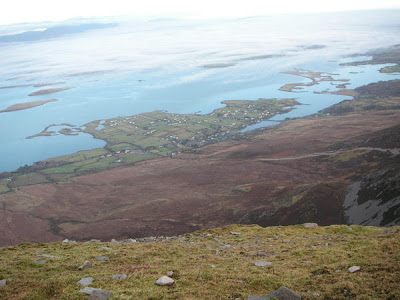Today we drove from Galway to Sligo. Along the way we stopped to see the National Famine Monument. This piece of art by John Behan is called "Coffin Ship". It is an impressive monument showing a ship full of skeletons as a symbol to remember all the people who died on the ships to America 160 years ago when they wanted to escape Ireland's potato famine in the 19th century.
Irelands population declined from 8 million to 4 million during the famine. When the young people left Ireland for a new start and a chance at a better life in America, the family and friends would gather together and have a wake-a funeral. This was done because the ones that were staying behind, knew they would never see their loved one(s) again. Half a million Irish families were forced from their homes by unscrupulous landlords.
The first coffin ships leaving Ireland, sailed for Quebec, Canada. The three thousand mile journey, could take up to three months. On board there was little food and unsanitary conditions for those packed aboard the crammed hulls. Upon arrival in the Saint Lawrence River, the ships were supposed to be inspected for disease and any sick passengers removed to a 150-bed quarantine facility on Grosse Isle, a small island thirty miles downstream from Quebec City. In spring 1847, 40 ships with 14,000 Irish immigrants arrived.
Stretched beyond their capacity, the medical staff took five days to see a patient. In the meantime, the Irish immigrants were left on the open beaches or put into make shift huts were they died by the thousands. There is the famous story of one little orphaned Irish boy who said he was tired and wanted to sit under a tree to rest. Shortly after sitting down to rest, he died where he sat, exhausted and alone.
Many pauper families had been told by their landlords that once they arrived in Canada, an agent would meet them and pay out between two and five pounds depending on the size of the family. But there were no agents. Promises of money, food and clothing had been utterly false. Landlords knew that once the paupers arrived in Canada there was virtually no way for them to ever return to Ireland and make a claim. Thus they had promised them anything just to get them out of the country.
Montreal received the biggest influx of Irish during this time. Many of those arriving were quite ill from typhus and long-term malnutrition. Montreal's limited medical facilities at Point St. Charles were quickly overwhelmed. Homeless Irish wandered the countryside begging for help as temperatures dropped and the frosty Canadian winter set in. But they were shunned everywhere by Canadians afraid of contracting fever.

Many of those that survived the journey, walked across the border to begin their new lives in America. They had no desire to live under the Union Jack flag in sparsely populated British North America. They viewed the United States with its anti-British tradition and its bustling young cities as the true land of opportunity.
Americans, unfortunately, not only had an anti-British tradition dating back to the Revolutionary era, but also had an anti-Catholic tradition dating back to the Puritan era. America in the 1840s was a nation of about 23 million inhabitants, mainly Protestant. Many of the Puritan descendants now viewed the growing influx of Roman Catholic Irish with increasing dismay and they would have to endure more hardships in their new homeland.
I actually sat for about an hour near this monument reflecting on my ancestors. I wondered how many had to say goodbye to their home, their loved ones, the way of life they knew as they took the chance of a better life in America? I also wondered how many suffered and died on the journey, their families never knowing what happened to them. Obviously since I am here now, one of my direct ancestors made it to America and made a life. Now that I have returned to Ireland, the family history, the journey has come full circle and I can't help but be touched by this monument and this land of my ancestors.



Really cool monument.
ReplyDeleteThe skeletons floating are really eerie looking. Very effective to demenstrate what the artist wanted to get across to people.
ReplyDeleteVery sad.
ReplyDeleteImpressive.
ReplyDeleteThat memorial looks so haunted.
ReplyDeletenice writing.
ReplyDelete